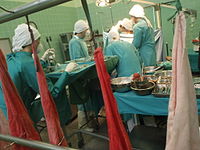
Photo from wikipedia
The clinical characteristics, management, and outcome of coronavirus disease 2019 (COVID‐19) caused by severe acute respiratory syndrome coronavirus 2 (SARS‐CoV‐2) after solid organ transplant (SOT) remain unknown. We report our… Click to show full abstract
The clinical characteristics, management, and outcome of coronavirus disease 2019 (COVID‐19) caused by severe acute respiratory syndrome coronavirus 2 (SARS‐CoV‐2) after solid organ transplant (SOT) remain unknown. We report our preliminary experience with 18 SOT (kidney [44.4%], liver [33.3%], and heart [22.2%]) recipients diagnosed with COVID‐19 by March 23, 2020 at a tertiary‐care center at Madrid. Median age at diagnosis was 71.0 ± 12.8 years, and the median interval since transplantation was 9.3 years. Fever (83.3%) and radiographic abnormalities in form of unilateral or bilateral/multifocal consolidations (72.2%) were the most common presentations. Lopinavir/ritonavir (usually associated with hydroxychloroquine) was used in 50.0% of patients and had to be prematurely discontinued in 2 of them. Other antiviral regimens included hydroxychloroquine monotherapy (27.8%) and interferon‐β (16.7%). As of April 4, the case‐fatality rate was 27.8% (5/18). After a median follow‐up of 18 days from symptom onset, 30.8% (4/13) of survivors developed progressive respiratory failure, 7.7% (1/13) showed stable clinical condition or improvement, and 61.5% (8/13) had been discharged home. C‐reactive protein levels at various points were significantly higher among recipients who experienced unfavorable outcome. In conclusion, this frontline report suggests that SARS‐CoV‐2 infection has a severe course in SOT recipients.
Journal Title: American Journal of Transplantation
Year Published: 2020
Link to full text (if available)
Share on Social Media: Sign Up to like & get
recommendations!